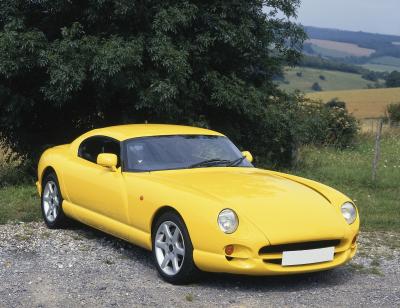
They say stuff sold by the ounce is always more expensive than stuff sold by the pound, and automotive paint is a sterling example of that. Counting in for materials and labor, pound for pound, that infinitesimally thin coat of color on your ride may just be the single most expensive thing on it. That's doubly true when you start looking beyond a basic, stock-color re-spray, and into newer and pricier shades. There are a huge number of variables involved in calculating the cost of a paint job, but most of them come down to three questions: what kind of paint do you want, how nice do you want it to look, and how much money are you willing to put into it?
A good paint job for a car requires extensive preparation, pricey materials and specialized skills. For this reason, the first factor in the price of painting a car will be the quality of work and the amount of time a garage puts into the job. First, the vehicle will be washed, the original paints will be sanded down and the chrome and windows will be covered. After the preparation has been completed, a thick primer is applied to smooth the body panels and provide some material for final sanding and smoothing. Next comes one or more layers of colored paint, often topped by a "clear coat" that adds some protection and depth of shine. Sometimes the clear coat is tinted with pigment, or contains additives for various finishes. Different paint shops may treat each stage differently. Some may run through preparation quickly, while others will take the time to do detailed work. The quality of work depends on what a consumer is willing to pay for the job.
Besides the cost of labor, several materials are included in the cost of painting a car. Someone who decides to paint his own car should expect to purchase some specialized tools such as a spray gun and covers for windows and chrome. Those who go to a garage will still be paying for primer, paint and the clear coatings. Because several layers of each paint are required, a full complement of decent materials can fall in the range of $1,000 to $1,500. But like everything else, these prices can change dramatically based upon quality. Top-of-the-line paints that change colors, or contain metallic, pearlescent or iridescent additives can cost more than $5,000, while the most basic varieties can be found for only a few hundred dollars. Some colors, especially reds, can also cost more. Vehicle size is an obvious if often overlooked consideration, because it takes three times as much paint to cover a Hummer as a Geo Metro.
Labor costs vary greatly in different areas. While quick paint jobs can be found for under $500, preparation is usually nonexistent and the application of paint tends to be uneven and sloppy. Most garages will complete the entire process from preparation to finish for $2,000 to $3,000 in labor. The cost of labor will also rise and fall with the size of a vehicle, largely because of the preparation process. Many garages include minor body work such as the removal of scratches and small dents during a paint job, but the best will take the time to sculpt a vehicle's panels into dead-straight canvases for the thin paint to lie on. Often, it's this preparation that makes the difference between a bargain re-spray and a stunning showpiece. Upper-end labor costs can reach $50,000 or more, but these prices tend to be reserved for vehicles that require lots of body preparation, or get specialized paint jobs like fades, two-tones, stripes or pinstriping, or "candy" colors that require very experienced painters.
With the combination of labor and materials, a typical decent paint job will be in the range of $3,000 to $4,500. It's also worth bearing in mind that changing the color of a vehicle's paint from stock can add 25 percent or more to the price, because the painters have to paint under the hood, inside the door jambs, under the trunk lid, and anywhere else the factory paint will show. The labor costs alone for a full color change can add up quickly, as all of these difficult-to-reach areas must be stripped, sanded, masked and primed like any other.
Certainly, you can save a lot of money spraying the vehicle yourself -- but that isn't usually practical given the buy-in cost of tools and materials, and the expertise required to lay down a good paint job. The reality is that very few first paint jobs end up as cheap as expected, or look like anything you'd want your friends to see; so it's probably best to leave the spraying itself to professionals. But that doesn't mean you're stuck paying full shop prices. Prep work is something most moderately adept people can do at home, and the materials to do it are generally cheap and readily available. Putting in some elbow grease beforehand, and showing up at the paint shop with your car on a trailer, already smoothed, sanded and masked can easily cut thousands off the price of the total job. And you should get your car back in a few days, instead of a few weeks or even months.